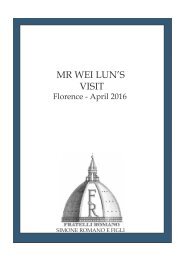A selection of master drawings 2016
- No tags were found...
Create successful ePaper yourself
Turn your PDF publications into a flip-book with our unique Google optimized e-Paper software.
15<br />
Giuseppe Bernardino Bison<br />
Palmanova 1762 - 1844 Milan<br />
Idyll with Spinner<br />
Pen, brown ink, wash and black chalk on laid paper<br />
179 x 254 mm (7 x 10 in.)<br />
Iscriptions: signed bottom right in ink Bison; on the verso upper left corner in pencil Bison: Due Filatrici,<br />
at the centre in pencil GB, bottom right corner in pencil 62.<br />
Provenance: O. Basilio collection, Trieste; private collection, Trieste.<br />
Exhibited: Cento disegni del Bison, exhibition catalogue by A. Rizzi, Udine, 1962.<br />
The role <strong>of</strong> Drawing in the artistic journey <strong>of</strong> the Friuliborn<br />
Giuseppe Bernardino Bison was fundamental over<br />
the whole span <strong>of</strong> his long and prolific career. After<br />
having studied the “elements <strong>of</strong> figure” with a pupil<br />
<strong>of</strong> Tiepolo, Costantino Cedini, Bison applied himself<br />
with particular interest to the study <strong>of</strong> perspective at<br />
the Accademia in Venice. Ever since the first years <strong>of</strong> his<br />
training, Bison pitched the first bases for his production<br />
as an easel painter, decorator and vedutista and today<br />
he is recognised as one <strong>of</strong> the greatest representatives <strong>of</strong><br />
Venetian vedutismo. It was thanks to his collaboration<br />
with the architect Giannantonio Selva that Bison<br />
worked in Ferrara in Palazzo Bottoni (1787), and then<br />
in Treviso, in the Casino Soderini (1796). Finally he<br />
moved to Trieste, where he spent thirty years <strong>of</strong> his life.<br />
Here he obtained unprecedented success and decorated<br />
some <strong>of</strong> the most prestigious private and public buildings<br />
<strong>of</strong> the city, including the famous Teatro Nuovo 1 , without<br />
ever neglecting his tireless production <strong>of</strong> easel works.<br />
After a brief stay in Venice around 1800, Bison moved<br />
to Trieste, working as a set designer. In his later life, he<br />
visited Florence and Rome, which he depicted in some <strong>of</strong><br />
his most sticking painted city views. At the age <strong>of</strong> sixtynine<br />
he finally moved to Milan, where he died in 1844.<br />
Within Bison’s graphic oeuvre, it is hard to find a<br />
preparatory drawing for a painting, whether this be a<br />
veduta, a landscape, a countryside scene or a painting<br />
with a mythological or sacred subject. Each invention<br />
finds its origin in the creative force <strong>of</strong> the artist and is<br />
born <strong>of</strong> the recomposition <strong>of</strong> fragments <strong>of</strong> his personal<br />
visual memory, sometimes authentic acts <strong>of</strong> homage to<br />
Tiepolo, both father and son, or to Francesco Guardi,<br />
Canaletto, Marco Ricci and Francesco Zuccarelli.<br />
Our drawing is an exquisite example <strong>of</strong> this aspect<br />
<strong>of</strong> Bison’s graphic output, where his pen strokes are<br />
immediate, his line pure, slight and delicate, and<br />
where the brown wash imbues the composition with a<br />
subtle painterly effect. Idyll with Spinner may thus be<br />
considered a self-contained, finished work probably<br />
intended for sale as an autonomous picture, and thus<br />
signed for that reason. This <strong>master</strong>piece met the taste<br />
<strong>of</strong> the times and even today has a bewitching quality<br />
which succeeds in capturing the observer’s gaze. We<br />
are looking at a «splendid drawing, worthy <strong>of</strong> Goya. The<br />
energetically expressive realism, the product <strong>of</strong> a vigour at<br />
once rhythmic and linear, critical and psychological, marks<br />
a leap forward into the future in relation to iconographic<br />
and aesthetic standards that were only just beginning to<br />
take root in Italian culture. The graphic litany, purged <strong>of</strong><br />
its traditional dross, is wholly Romantic in feel». 2 That was<br />
how Aldo Rizzi described our drawing in the exhibition<br />
catalogue Cento Disegni del Bison (Udine, 1962), when<br />
it was chosen for the poster advertising the exhibition<br />
on the grounds that perfectly encapsulated the artist’s<br />
imagination and creative talent.<br />
1 Bison had already undertaken many commissions independently<br />
before arriving in Trieste. For example the decorations for the<br />
Teatro Nuovo and Degli Obizzi in Ferrara (around 1790) and<br />
the many works in the Treviso region. Cf. F. Magani, Giuseppe<br />
Bernardino Bison, Soncino (CR), 1993, pp. 9-12.<br />
2 Cf. Cento disegni del Bison, exhibition catalogue by A. Rizzi,<br />
Udine, 1962, p. 56.





